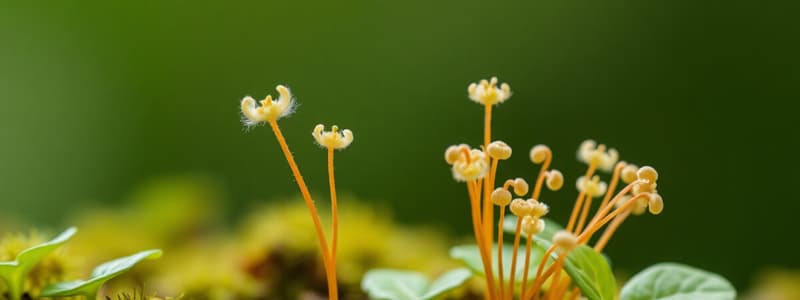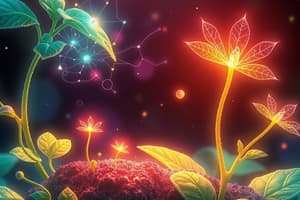Podcast
Questions and Answers
What is the primary function of gibberellins in plants?
What is the primary function of gibberellins in plants?
- Promote leaf senescence
- Stimulate root growth and development
- Inhibit seed germination
- Stimulate shoot elongation and fruit maturation (correct)
Which of the following accurately describes mycorrhizae?
Which of the following accurately describes mycorrhizae?
- Fungi that solely parasitize living plant roots
- A symbiotic association between fungi and plant roots (correct)
- Fungi that thrive in aquatic environments
- Plants that grow on other plants for nutrition
Which characteristic distinguishes saprophytes from other types of organisms?
Which characteristic distinguishes saprophytes from other types of organisms?
- Engage in symbiotic relationships with plants
- Obtain food from living plants directly
- Obtain food from decomposing organic matter (correct)
- Contain chlorophyll for photosynthesis
Which feature is NOT typically associated with animals?
Which feature is NOT typically associated with animals?
What defines the body plan of animals, particularly in relation to embryonic tissue layers?
What defines the body plan of animals, particularly in relation to embryonic tissue layers?
What term describes animals that have three tissue types in their embryo?
What term describes animals that have three tissue types in their embryo?
Which body plan allows for equal environmental interaction from all directions?
Which body plan allows for equal environmental interaction from all directions?
What is the main characteristic of a coelom?
What is the main characteristic of a coelom?
Which developmental process produces three primary germ layers?
Which developmental process produces three primary germ layers?
Which group of animals develops the mouth second during embryonic development?
Which group of animals develops the mouth second during embryonic development?
Which type of epithelial tissue is characterized by its flat, overlapping cells?
Which type of epithelial tissue is characterized by its flat, overlapping cells?
In which structure do muscle cells attach in vertebrates?
In which structure do muscle cells attach in vertebrates?
What type of skeleton allows limbless animals to move through coordinated contractions?
What type of skeleton allows limbless animals to move through coordinated contractions?
What is the primary substance that gives connective tissue its density?
What is the primary substance that gives connective tissue its density?
Which of the following is a defining feature of cells in the blood?
Which of the following is a defining feature of cells in the blood?
What characterizes cartilaginous fish such as sharks and rays?
What characterizes cartilaginous fish such as sharks and rays?
Which of the following is a trait unique to amphibians compared to other vertebrates?
Which of the following is a trait unique to amphibians compared to other vertebrates?
What is the primary function of the swim bladder in bony fish?
What is the primary function of the swim bladder in bony fish?
How do reptiles generally reproduce?
How do reptiles generally reproduce?
What adaptation do amniotes have that provides a protective environment for embryos?
What adaptation do amniotes have that provides a protective environment for embryos?
What characterizes the reproductive strategy of ovoviviparous sharks?
What characterizes the reproductive strategy of ovoviviparous sharks?
Which of the following terms refers to organisms with jaws, including fishes and tetrapods?
Which of the following terms refers to organisms with jaws, including fishes and tetrapods?
What unique feature characterizes salamanders among amphibians?
What unique feature characterizes salamanders among amphibians?
Which feature is found in all reptiles but not in amphibians?
Which feature is found in all reptiles but not in amphibians?
Which of the following traits is NOT characteristic of bony fish?
Which of the following traits is NOT characteristic of bony fish?
What process is responsible for the formation of coelom in protostomes?
What process is responsible for the formation of coelom in protostomes?
Which characteristic is NOT true about sponges?
Which characteristic is NOT true about sponges?
What defines the unique body plan of mollusks?
What defines the unique body plan of mollusks?
What is the primary function of nematocysts in cnidarians?
What is the primary function of nematocysts in cnidarians?
Which class of cnidarians is known for having a life cycle that includes both polyp and medusa forms?
Which class of cnidarians is known for having a life cycle that includes both polyp and medusa forms?
Which structure is associated with the lophotrochozoan phyla?
Which structure is associated with the lophotrochozoan phyla?
What structure do arthropods primarily use for protection from predators?
What structure do arthropods primarily use for protection from predators?
In which group can you find organisms that undergo ecdysis?
In which group can you find organisms that undergo ecdysis?
What type of body symmetry is exhibited by cnidarians?
What type of body symmetry is exhibited by cnidarians?
What is the main feature that distinguishes echinoderms from other animal phyla?
What is the main feature that distinguishes echinoderms from other animal phyla?
Which of the following is a characteristic of annelids?
Which of the following is a characteristic of annelids?
What is the function of the clitellum in some annelids?
What is the function of the clitellum in some annelids?
Which group of mollusks is known for having a shell composed of multiple plates?
Which group of mollusks is known for having a shell composed of multiple plates?
What role do chaetae play in annelids?
What role do chaetae play in annelids?
Flashcards
Gibberellins (GA's)
Gibberellins (GA's)
Plant hormones that stimulate shoot elongation, seed germination, and fruit/flower maturation.
Auxins
Auxins
Plant hormones primarily responsible for cell elongation in phototropism and gravitropism, also control meristem differentiation.
Mycorrhizae
Mycorrhizae
Symbiotic relationship between fungi and plant roots, where fungi are integrated into the root structure. Plants gain nutrients, fungi gain energy from the plant.
Epiphyte
Epiphyte
Signup and view all the flashcards
Animal characteristics
Animal characteristics
Signup and view all the flashcards
Triploblastic animals
Triploblastic animals
Signup and view all the flashcards
Radial symmetry
Radial symmetry
Signup and view all the flashcards
Bilateral symmetry
Bilateral symmetry
Signup and view all the flashcards
Coelom
Coelom
Signup and view all the flashcards
Blastula
Blastula
Signup and view all the flashcards
Gastrula
Gastrula
Signup and view all the flashcards
Protostomes
Protostomes
Signup and view all the flashcards
Deuterostomes
Deuterostomes
Signup and view all the flashcards
Tube-within-a-tube body plan
Tube-within-a-tube body plan
Signup and view all the flashcards
Epithelial tissue types
Epithelial tissue types
Signup and view all the flashcards
Gill slits
Gill slits
Signup and view all the flashcards
Dorsal hollow nerve cord
Dorsal hollow nerve cord
Signup and view all the flashcards
Notochord
Notochord
Signup and view all the flashcards
Post-anal tail
Post-anal tail
Signup and view all the flashcards
Vertebrate Fish (Chondrichthyes)
Vertebrate Fish (Chondrichthyes)
Signup and view all the flashcards
Ovoviviparous Reproduction
Ovoviviparous Reproduction
Signup and view all the flashcards
Oviparous Reproduction
Oviparous Reproduction
Signup and view all the flashcards
Bony Skeleton
Bony Skeleton
Signup and view all the flashcards
Swim Bladder
Swim Bladder
Signup and view all the flashcards
Amphibians
Amphibians
Signup and view all the flashcards
Protostome coelom formation
Protostome coelom formation
Signup and view all the flashcards
Deuterostome coelom formation
Deuterostome coelom formation
Signup and view all the flashcards
Ecdysozoans
Ecdysozoans
Signup and view all the flashcards
Porifera (Sponges)
Porifera (Sponges)
Signup and view all the flashcards
Sponge body types
Sponge body types
Signup and view all the flashcards
Cnidaria
Cnidaria
Signup and view all the flashcards
Polymorphic Cnidarians
Polymorphic Cnidarians
Signup and view all the flashcards
Lophotrochozoa
Lophotrochozoa
Signup and view all the flashcards
Platyhelminthes
Platyhelminthes
Signup and view all the flashcards
Annelida
Annelida
Signup and view all the flashcards
Mollusca
Mollusca
Signup and view all the flashcards
Ecdysis
Ecdysis
Signup and view all the flashcards
Nematoda
Nematoda
Signup and view all the flashcards
Arthropoda
Arthropoda
Signup and view all the flashcards
Echinodermata
Echinodermata
Signup and view all the flashcards
Study Notes
Plant Hormones
- Gibberellins (GAs) stimulate shoot elongation, seed germination, and fruit/flower maturation
- Auxins control meristem differentiation and are responsible for cell elongation in phototropism and gravitropism
Mycorrhizae
- Symbiotic fungi associated with plant roots
- Fungi are integrated into the root's physical structure
- Plants obtain essential elements from the soil
- Fungus obtains nutrients from plants
Epiphytes
- Plants that grow on other plants
- Not dependent on a host plant for nutrition
- Two types of roots: clinging aerial and aerial
- Clinging aerial roots absorb nutrients from humus accumulated in trees
- Aerial roots absorb moisture from the atmosphere
Saprophytes
- Lack chlorophyll
- Obtain food from dead organic matter
- Enzymes break down organic food materials into simpler forms
- Many parasitize fungi that digest dead matter or are mycorrhizal
Choanoflagellates
- Sessile protists, some colonial
Sponges
-
Multicellular, sessile animals
-
Major animal characteristics: multicellular, heterotrophs, and move at some point in their lives
Body Plans
- Asymmetry: Sponges
- Radial symmetry: Body parts arranged around a central axis, allowing organisms to experience the environment equally in all directions (e.g., Cnidarians)
- Bilateral symmetry: Body parts arranged along a single plane (e.g., most animals)
Body Cavities
- Coelom: A fluid-filled body cavity surrounded by mesoderm; found in some animals
- Diploblasts lack a coelom; coelom is enclosed, fluid filled body cavity in some animals
Blastula & Gastrula
- Blastula: Rapidly dividing cells that transition to gastrula, which develops specialized cells.
- Gastrula comprises of three primary germ layers: ectoderm, endoderm, and mesoderm.
Hydrostatic Skeletons
- Allow limbless animals to move via coordinated muscle contractions
Tube-within-a-tube body plan
- Protostomes or deuterostomes
- Outer tube forms body wall and inner tube forms digestive tract
- Digestive system formed from endoderm
- Body wall formed from ectoderm
- Muscles and organs formed by mesoderm
Protostomes and Deuterostomes
- Protostomes: Mouth develops first
- Deuterostomes: Anus develops first
Epithelial Tissues (Summary)
- Squamous: Flattened, overlapping cells (e.g., skin, mouth)
- Columnar: Long and wide cells (e.g., nose, trachea)
- Transitional: Elongated, compacted cells (e.g., urinary bladder)
Animal Body Plan Features
- Number of embryonic tissue layers
- Diploblasts: 2 tissue layers (endoderm and ectoderm).
- Triploblasts: 3 tissue layers (endoderm, ectoderm, mesoderm).
- Presence/absence of fluid-filled body cavity (coelom)
- Nervous system, body symmetry, and cephalization (development of a head region)
- Earliest events of embryonic development
Triploblasts
- Animals with three tissue layers
Animal Development Gastrulation
- Process that develops blastopore (hollow) from zygote (fertilized egg).
- Germ layers form during this process (ectoderm, endoderm, and mesoderm)
- These layers develop into organ systems (tissues, organs, etc).
Mouth Development (Summary)
- Two major groups
- Protostomes
- Mesoderm separates to form body cavity in schizocoely process
- Deuterostomes
- Mesoderm pinches off (enterocoely process) body cavity
Animal Phylogeny
- Specialized tissue
- Symmetry
- Coelom
- Protostome vs. deuterostome
Animal Phylogeny: Defining Features of Groups
- Porifera: Sponges, mostly marine, no true tissues. Suspension feeders, filtering water through their porous bodies. Reproduction: (asexual budding, sexual – eggs + sperm).
- Cnidaria: Jellyfish, corals, anemones. Primarily marine. Diploblastic. Radial symmetry. 2 body forms (polyp and medusa). Stinging cells (nematocysts) for predation
- Lophotrochozoa: Bilateral symmetry. Coelom present in some. Not all undergo a larval stage. Flatworms, annelids, and mollusks.
- Platyhelminthes: (Flatworms) – dorsoventrally flattened bodies. Most are free-living, some are parasitic. No coelom, but have a simple digestive system.
- Annelida: (Segmented worms) – Bodies subdivided into repeating segments. True coelom, complex digestive and circulatory systems.
- Mollusca: Snails, clams, octopuses. Soft-bodied animals, often with a hard shell (calcium carbonate). Well-developed muscular foot, visceral mass, mantle.
- Ecdysozoa: Grow by shedding their external covering. Bilateral symmetry. Segmented bodies and jointed legs. Protostomes. Nematodes (roundworms), and arthropods.
- Nematoda: (Roundworms) – Unsegmented, tubular bodies with a pseudocoelom. Most are free-living, some are parasitic.
- Arthropoda: Insects, crustaceans, arachnids. Segmented bodies, exoskeleton made of chitin, jointed appendages, well-developed sensory organs. Bilateral symmetry. Complex digestive, respiratory, and circulatory systems.
- Echinodermata: Starfish, sea urchins, sea cucumbers. Primarily marine. Bilateral symmetry as larvae, radial symmetry as adults. Water vascular system for movement and feeding. Endoskeleton. Unique deuterostome lineage.
Studying That Suits You
Use AI to generate personalized quizzes and flashcards to suit your learning preferences.




